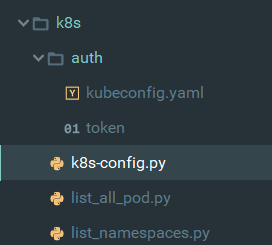通过将身份认证令牌直接传给 API 服务器,可以避免使用 kubectl 代理,像这样:
使用 grep/cut 方式:
通过将身份认证令牌直接传给 API 服务器,可以避免使用 kubectl 代理,像这样: 使用 grep/cut 方式: # 查看所有的集群,因为你的 .kubeconfig 文件中可能包含多个上下文 kubectl config view -o jsonpath=‘{"Cluster name\tServer\n"}{range .clusters[*]}{.name}{"\t"}{.cluster.server}{"\n"}{end}‘ # 从上述命令输出中选择你要与之交互的集群的名称 export CLUSTER_NAME="some_server_name" # 指向引用该集群名称的 API 服务器 APISERVER=$(kubectl config view -o jsonpath="{.clusters[?(@.name==\"$CLUSTER_NAME\")].cluster.server}") # 获得令牌 TOKEN=$(kubectl get secrets -o jsonpath="{.items[?(@.metadata.annotations[‘kubernetes\.io/service-account\.name‘]==‘default‘)].data.token}"|base64 -d) # 使用令牌玩转 API curl -X GET $APISERVER/api --header "Authorization: Bearer $TOKEN" --insecure
客户端库:https://kubernetes.io/zh/docs/reference/using-api/client-libraries/
python举例:
目录结构

配置文件两种方式
1、将集群中的~/.kube/config,重命名为kubeconfig.yaml
代码:
from kubernetes import client,config from kubernetes.stream import stream import yaml config_file = r"D:\Users\JackHe\PycharmProjects\JJ\k8s\auth\kubeconfig.yaml" config.kube_config.load_kube_config(config_file=config_file) Api_Instance = client.CoreV1Api() Api_Batch = client.BatchV1Api() #列出所有的namesapce for ns in Api_Instance.list_namespace().items: print(ns.metadata.name) #列出所有的nodes def list_node(): api_response = Api_Instance.list_node() data = {} for i in api_response.items: data[i.metadata.name] = {"name": i.metadata.name, "status": i.status.conditions[-1].type if i.status.conditions[-1].status == "True" else "NotReady", "ip": i.status.addresses[0].address, "kubelet_version": i.status.node_info.kubelet_version, "os_image": i.status.node_info.os_image, } return data nodes = list_node() print(nodes)
2、使用token形式,获取命令上文所示。
代码:
# -*- coding: utf-8 -*- from kubernetes.client import api_client from kubernetes.client.apis import core_v1_api from kubernetes import client,config class KubernetesTools(object): def __init__(self): self.k8s_url = ‘https://192.168.1.56:6443‘ def get_token(self): """ 获取token :return: """ with open(r‘D:\Users\JackHe\PycharmProjects\JJ\k8s\auth\token‘, ‘r‘) as file: Token = file.read().strip(‘\n‘) return Token def get_api(self): """ 获取API的CoreV1Api版本对象 :return: """ configuration = client.Configuration() configuration.host = self.k8s_url configuration.verify_ssl = False configuration.api_key = {"authorization": "Bearer " + self.get_token()} client1 = api_client.ApiClient(configuration=configuration) api = core_v1_api.CoreV1Api(client1) return api def get_namespace_list(self): """ 获取命名空间列表 :return: """ api = self.get_api() namespace_list = [] for ns in api.list_namespace().items: # print(ns.metadata.name) namespace_list.append(ns.metadata.name) return namespace_list def get_pod_list(self): api = self.get_api() print("Listing pods with their IPs:") ret = api.list_pod_for_all_namespaces(watch=False) for i in ret.items: print("%s\t%s\t%s" % (i.status.pod_ip, i.metadata.namespace, i.metadata.name)) def get_service_list(self): api = self.get_api() ret = api.list_service_for_all_namespaces(watch=False) for i in ret.items: print("%s \t%s \t%s \t%s \t%s \n" %(i.kind,i.metadata.namespace,i.metadata.name,i.spec.cluster_ip,i.spec.ports)) if __name__ == ‘__main__‘: namespace_list = KubernetesTools().get_namespace_list() pod_list = KubernetesTools().get_pod_list() service = KubernetesTools().get_service_list() print(namespace_list) print(pod_list) print(service)
原文:https://www.cnblogs.com/Dev0ps/p/14825543.html